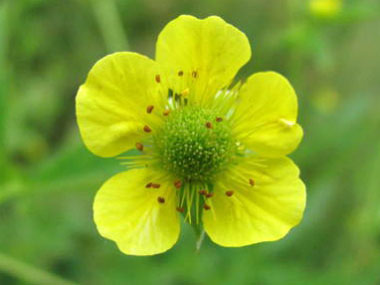






To support our efforts please browse our store (books with health benefits, etc.).
Yellow avens is a native flowering, perennial plant that is in the Rosaceae family. In fact, it grows in most of the temperate regions throughout the Northern Hemisphere. This plant was commonly used by many First Nation people and in particular the Cree; they called this plant kakwithitamowask. There is one other yellow flowered avens that can be confused with Geum aleppicum, the large-leaf avens (Geum macrophyllum). The base of the styles of these avens do not have hair, and the leaves have heart-shaped base segments. The white avens, (Geum canadense) is also similar and when not in flower, one must look to the leaves to tell the difference. White avens leaves are less lobed and the plant is less hairy. Later in the year this can be an annoying plant when hiking because of the bur-like clusters of seeds. Each seed has a long hooked beak (bur) that clings to clothing. These burs persist well into autumn and winter.
Distinguishing Features
Yellow avens is distinguished in the rosette stage of growth by long-stalked, pinnately compound leaves, each with a large terminal leaflet and irregularly sized and shaped lateral leaflets. Once in bloom, the tiny yellow flowers are easy to spot.
Flowers
Yellow flowers measure 1 to 2 cm across. They have hairy stalks with a green calyx that has five triangular sepals each with pointed tips and hairy underside surfaces. These reflex when the flower is open. The corolla has five yellow petals broadest in the middle with rounded tips and narrowed bases. These are longer than the sepals. There are numerous stamens with greenish-yellow filaments and reddish-brown anthers. These surround a central green receptacle that has up to several hundred styles. These styles are jointed about 1/4 of the distance back from the tip and twisted at that point to form a hook. Bloom time is early June into late summer.
 Fields
of Nutrition has medicinal benefits and vitamin/mineral content of Yellow Avens.
Fields
of Nutrition has medicinal benefits and vitamin/mineral content of Yellow Avens.
Leaves
The leaves are lyrately divided with 2 to 6 pairs of leaflets, with both upper and lower surfaces sparsely hairy as are the leaf stalks. Leaflets are unequal with the terminal leaflet the largest and the lateral leaflets smaller but similar in shape; and on the larger basal leaves the additional lateral pairs will be smaller that the first pair. The overall leaf shape is rhombic to circular. Leaf margins are coarsely toothed. Upper stem leaves are smaller with the leaflets appearing to be just toothed lobes on the very upper leaves. The leaf stalks end with a pair of ovate leaf-like stipules that also have coarse toothed margins.
Height
Stems are erect and it grows to about 1 metre tall (3'). The stem is frequently branched toward the top.
Habitat
Yellow avens grows in meadows, open woods, pastures, waste areas and roadsides, but is rarely found in cultivated land. It grows throughout Canada, most states in the US, as well as in many European and Asian countries.
Edible Parts
Leaves are edible. The roots were used by First Nations people; roots smell like cloves.
Other Name
Common Avens.
Winter Survival Food Handbook

PDF Plant Magazines
Types of Wild Food
Geographic Zones Seasons
Disclaimer
EdibleWildFood.com is informational in nature. While we strive to be 100% accurate, it is solely up to the reader to ensure proper plant identification. Some wild plants are poisonous or can have serious adverse health effects.
We are not health professionals, medical doctors, nor are we nutritionists. It is up to the reader to verify nutritional information and health benefits with qualified professionals for all edible plants listed in this web site. Please click here for more information.
Why Edible Wild Food?
- Food costs are rising
- Free, wild food is readily abundant
- Wild food adds nutrition to your diet
- Wild food can help treat various medical conditions





